How to color buttercream dark colors like deep red and true black with a comparison of multiple types of food coloring to find out which works best.
I’ve colored buttercream dark colors for a long time now, but when I first started, I’d just use whatever food coloring I had on hand. I felt like some would do a better job, but never really sat down to do a comparison until now.
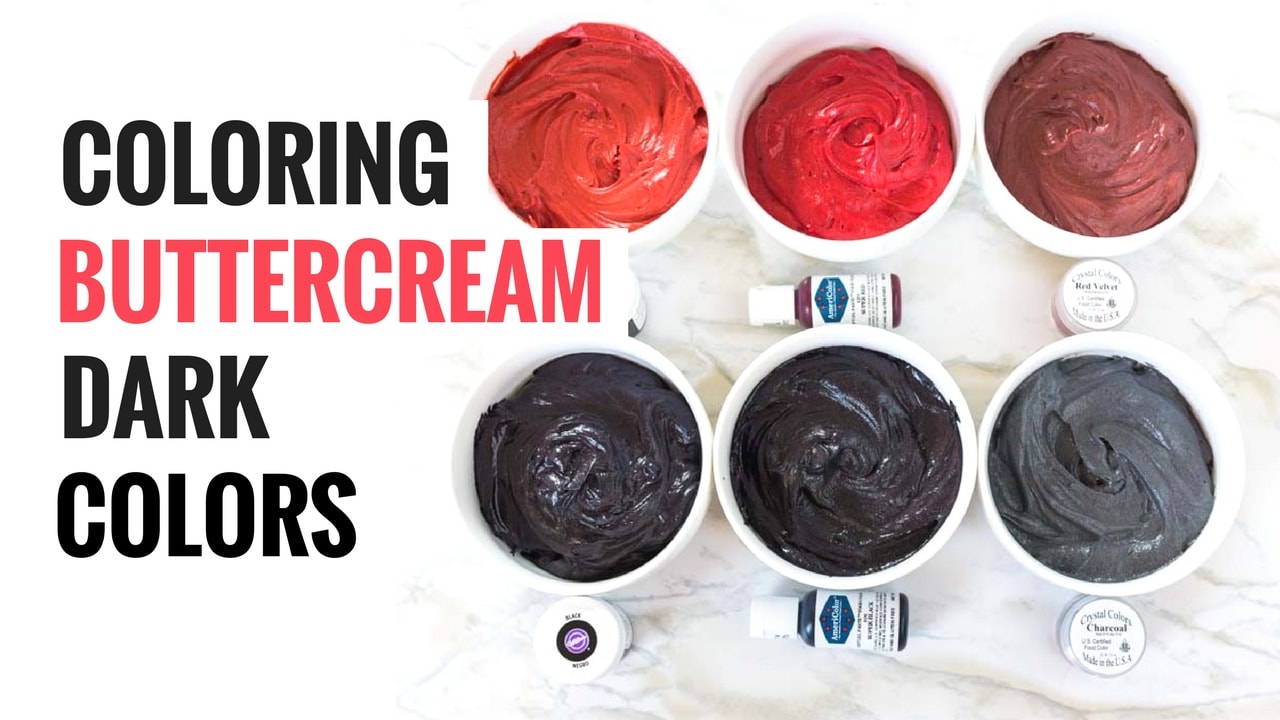
It’s a question I get asked quite a bit: How do I get buttercream a dark color without watering it down too much and without it tasting gross?
For this post, I decided to compare three different food color methods. Now, I know there are tons more, and you’re welcome to try others out, but for simplicity’s sake, I decided to just use three here.
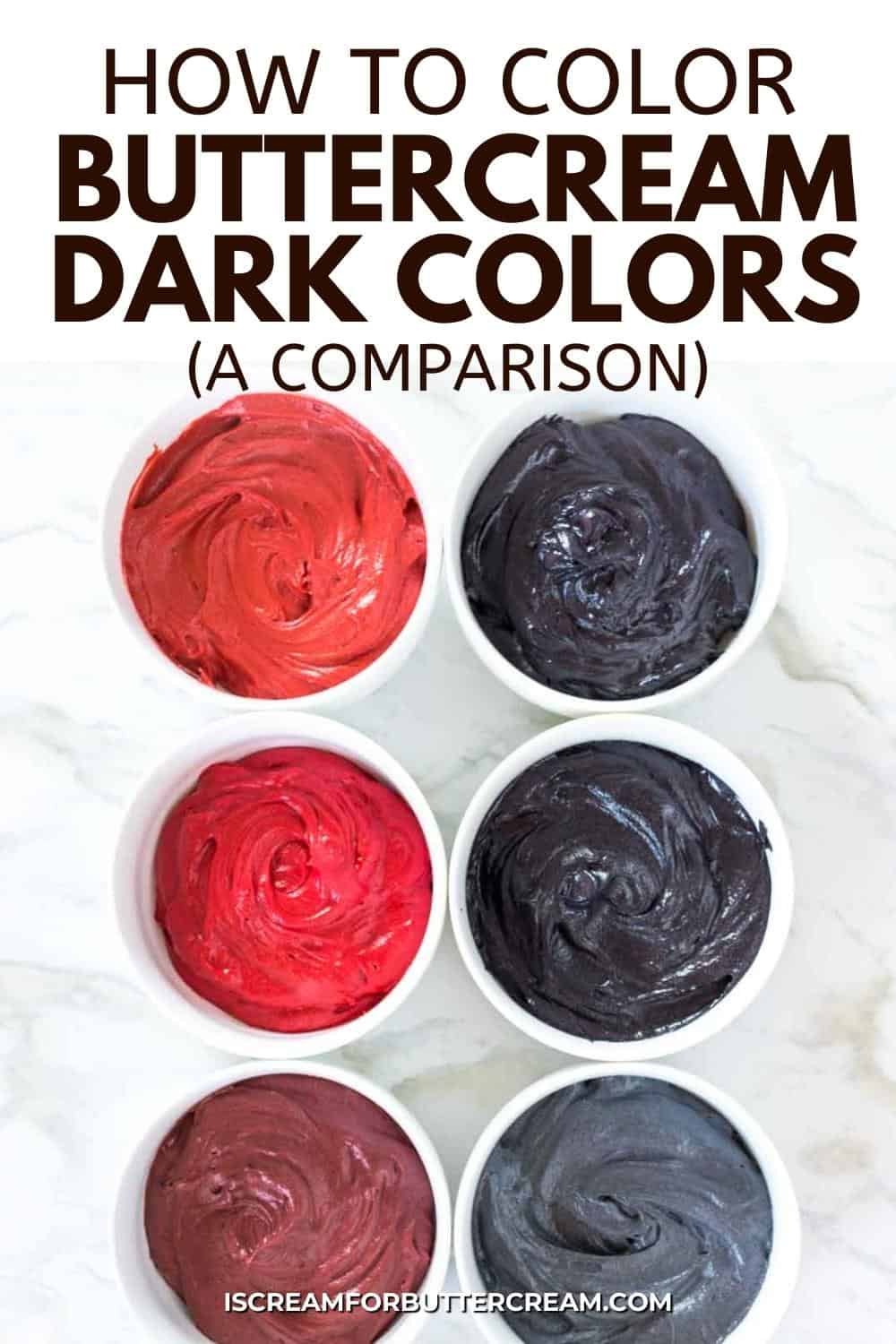
So, we’re going to compare these three popular food colorings to find out which one gives the best color, the best texture, and the least amount of food color taste.
I also decided to compare the two hardest colors to achieve: Red and Black
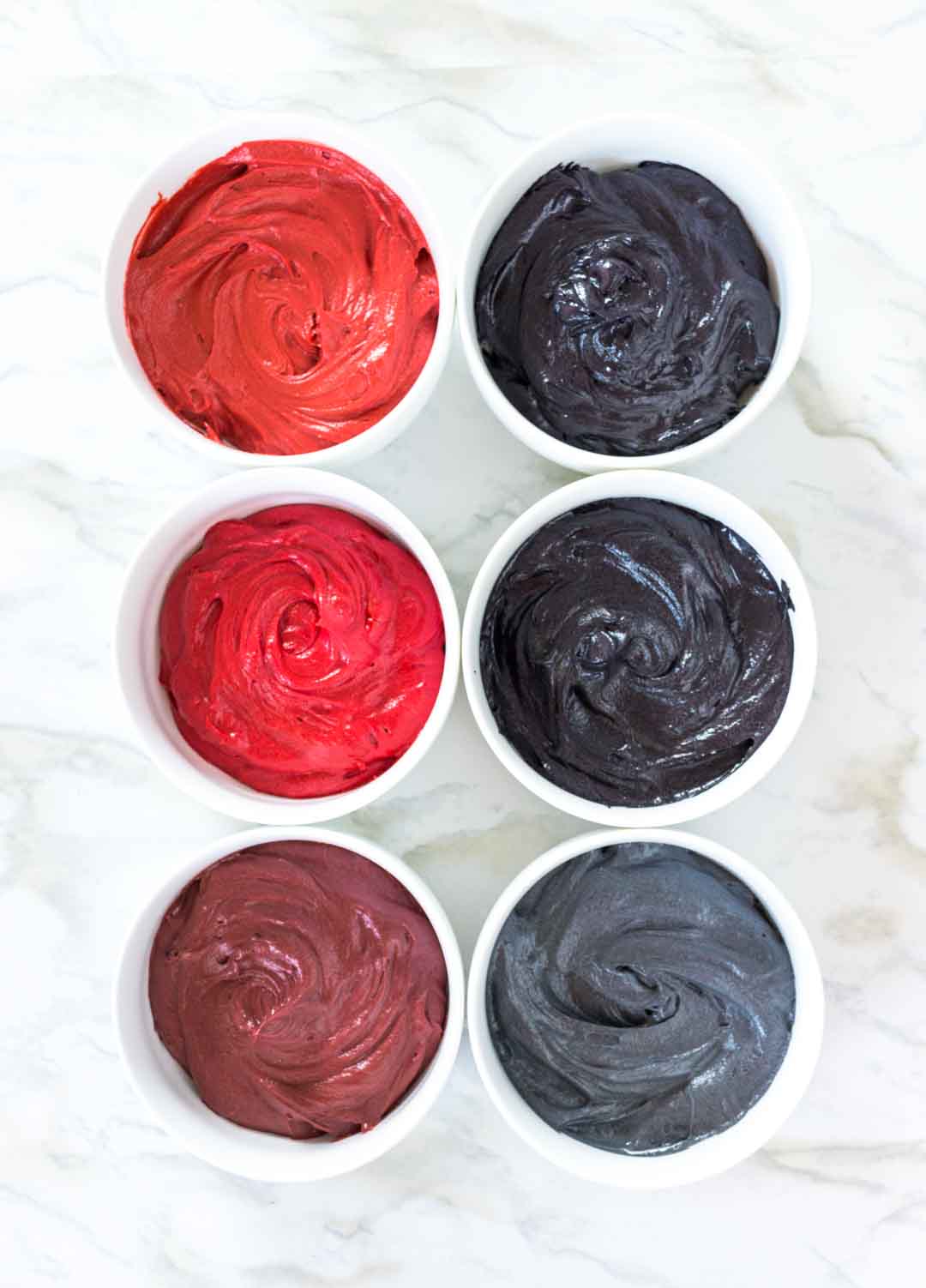
As an Amazon Associate, I earn from qualifying purchases.
Jump to:
The Comparison:
For this post, I compared:
- Wilton: Red No-Taste Gel Color & Black Gel Color
- Americolor: Super Red Soft Gel Color & Super Black Soft Gel Color
- Crystal Colors (Powder Color): Red Velvet & Charcoal
The Method:
- For each type of food coloring, I colored one cup of buttercream red and another cup black.
- I used all butter, buttercream. You can find that recipe here: Vanilla Bean Buttercream
- I like to add a couple of teaspoons of cocoa powder into my buttercream to pre-darken it and it helps with any bitter taste that might occur from the food coloring.
- I’ve also recently found that black cocoa powder does an amazing job at getting black buttercream and actually does not taste as chocolaty as regular cocoa powder. It gets the buttercream closer to black and you don’t have to add as much black gel food coloring.
The Results:
Wilton Gel Color:
No-Taste Red Gel Color:
I mixed together:
- 1 cup of buttercream
- 2 tsp. cocoa powder
- 1 ½ teaspoon gel color
The result:
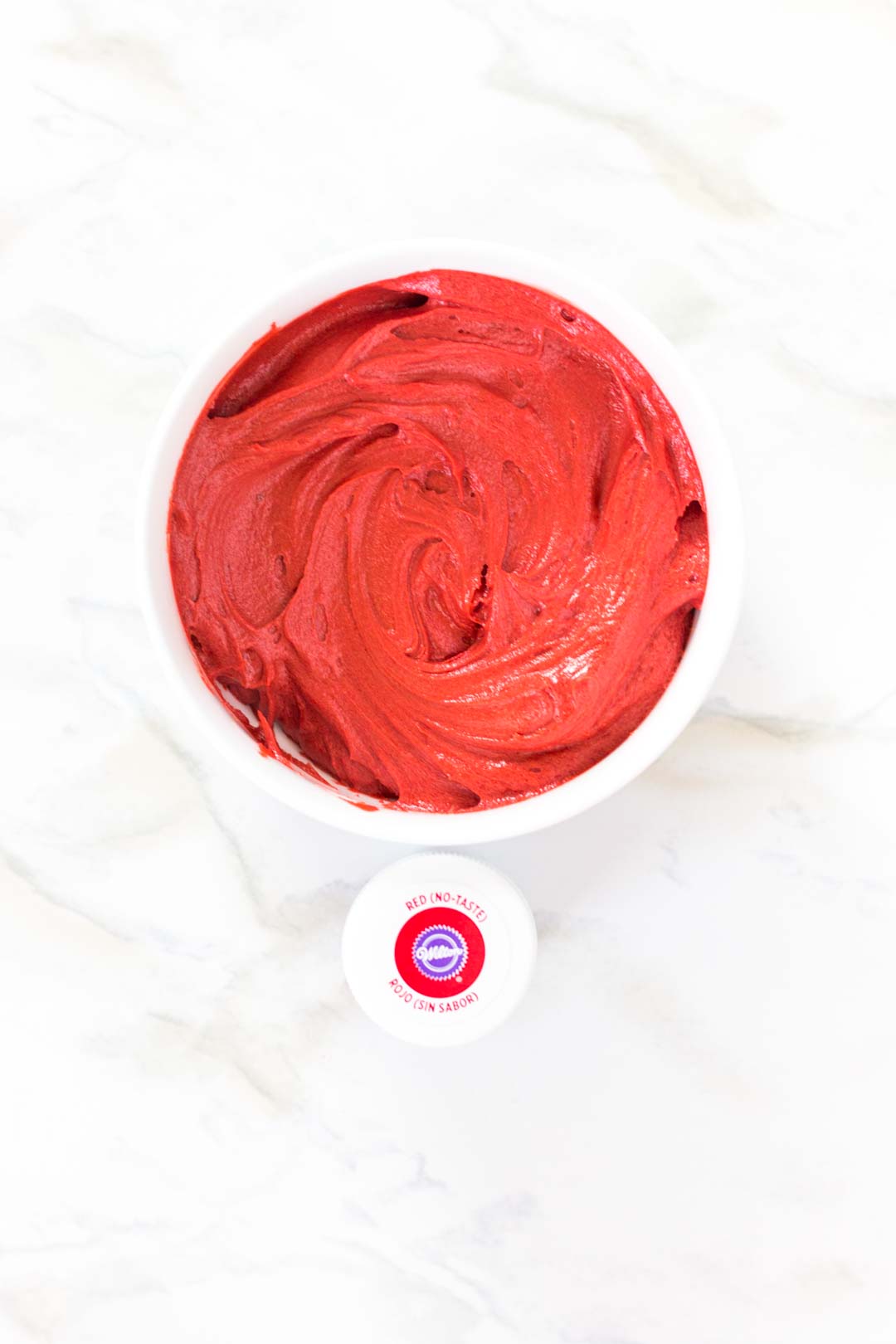
My comments:
The Wilton no-taste red makes a good tomato red color. I didn’t have to add an insane amount of it and it didn’t seem to dilute the buttercream. I also didn’t detect a bitter taste to it either.
Black Gel Color:
I mixed together:
- 1 cup of buttercream
- 2 tsp. cocoa powder (You can also use black cocoa powder which doesn’t have as strong a chocolate taste.)
- 1 ½ teaspoon gel color
The result:
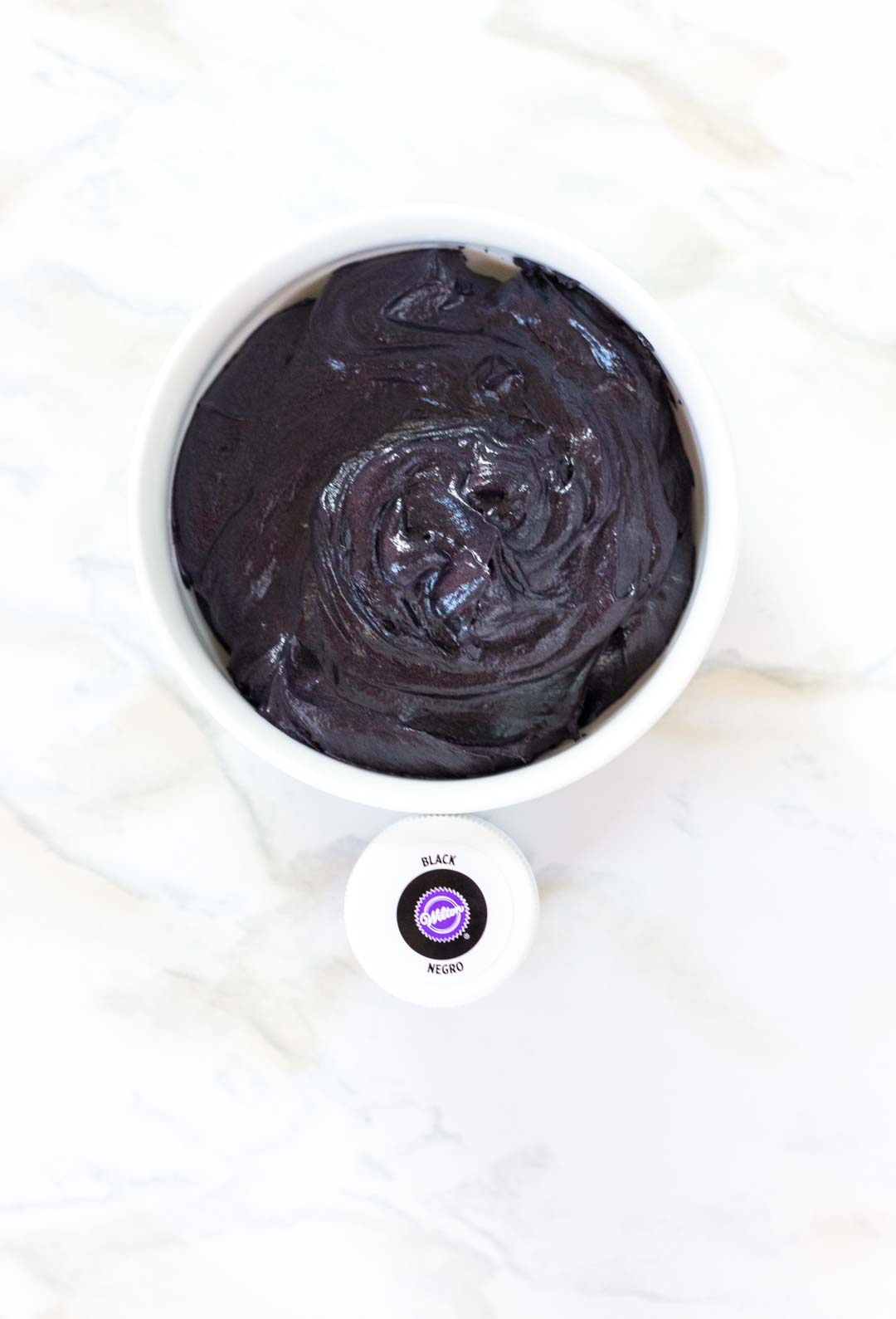
My comments:
The Wilton black worked well without having to use a ton of it. I also didn’t detect a bitter taste to this one either, however, the cocoa that was added to pre-darken it could have masked any bitterness.
Wilton Red & Black Side by Side Results:

Americolor Soft Gel Color:
Super Red Soft Gel Color:
I mixed together:
- 1 cup of buttercream
- 2 tsp. cocoa powder
- 1 teaspoon gel color
The result:
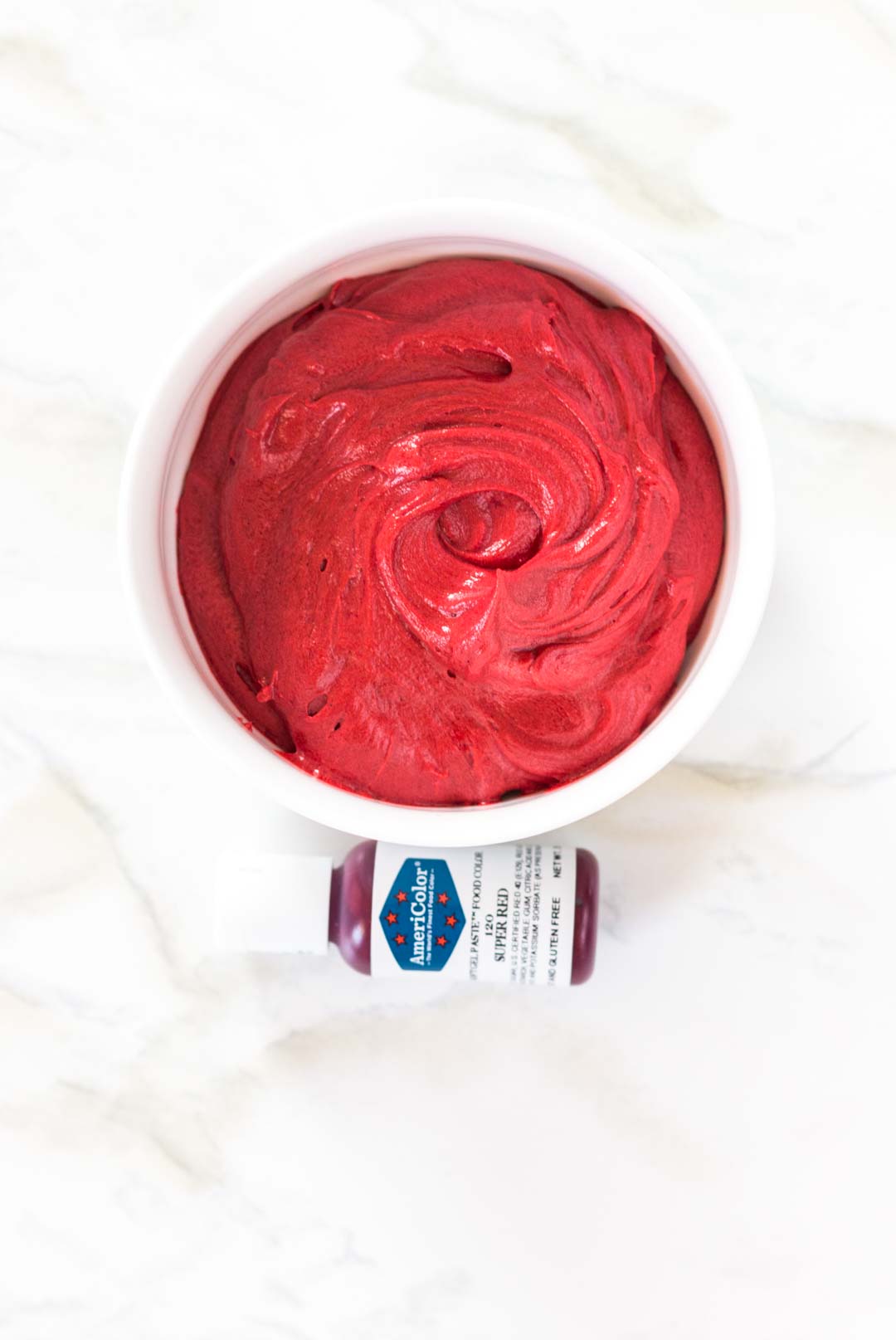
My comments:
I loved how this red came out. It seems deeper and more blue-red than Wilton red. This coloring is a little softer in texture than the Wilton gel coloring, so you may want to start with a thicker buttercream.
I didn’t detect any bitter taste, but the added cocoa powder could have masked that.
Super Black Soft Gel Color:
I mixed together:
- 1 cup of buttercream
- 2 tsp. cocoa powder (You can also use black cocoa powder which doesn’t have as strong a chocolate taste.)
- 1 ½ teaspoon gel color
The result:
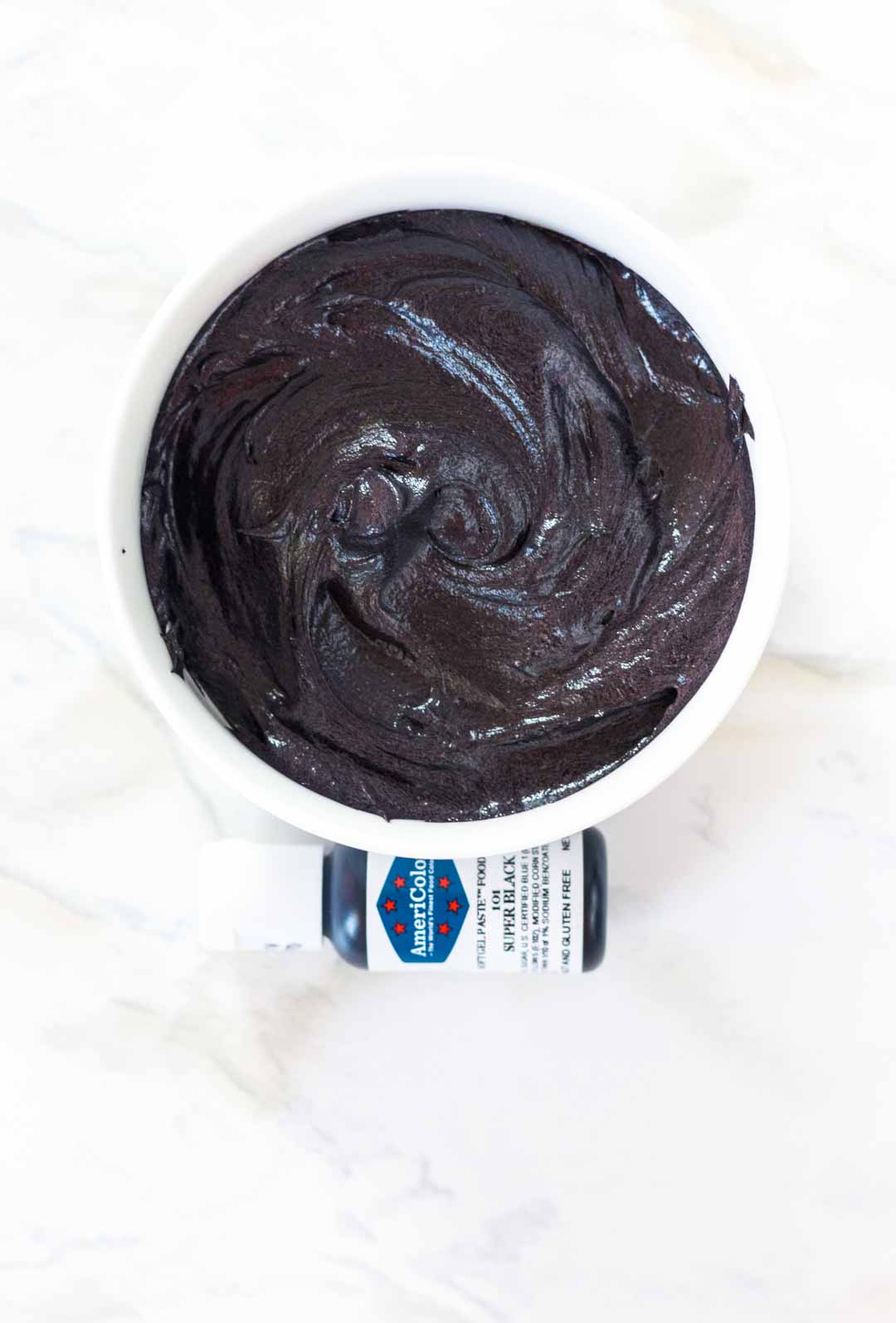
My comments:
This gel color worked really well. I couldn’t see a difference though between this one and the Wilton black gel coloring, so this one is your call. I didn’t taste a bitter taste to this one, but as with the others, the cocoa powder could have disguised that.
Americolor Red & Black Side by Side Results:

Crystal Colors Powder Color:
Red Velvet Powder Color:
I mixed together:
- 1 cup of buttercream
- 2 tsp. cocoa powder
- 3-4 teaspoon powder color
The result:
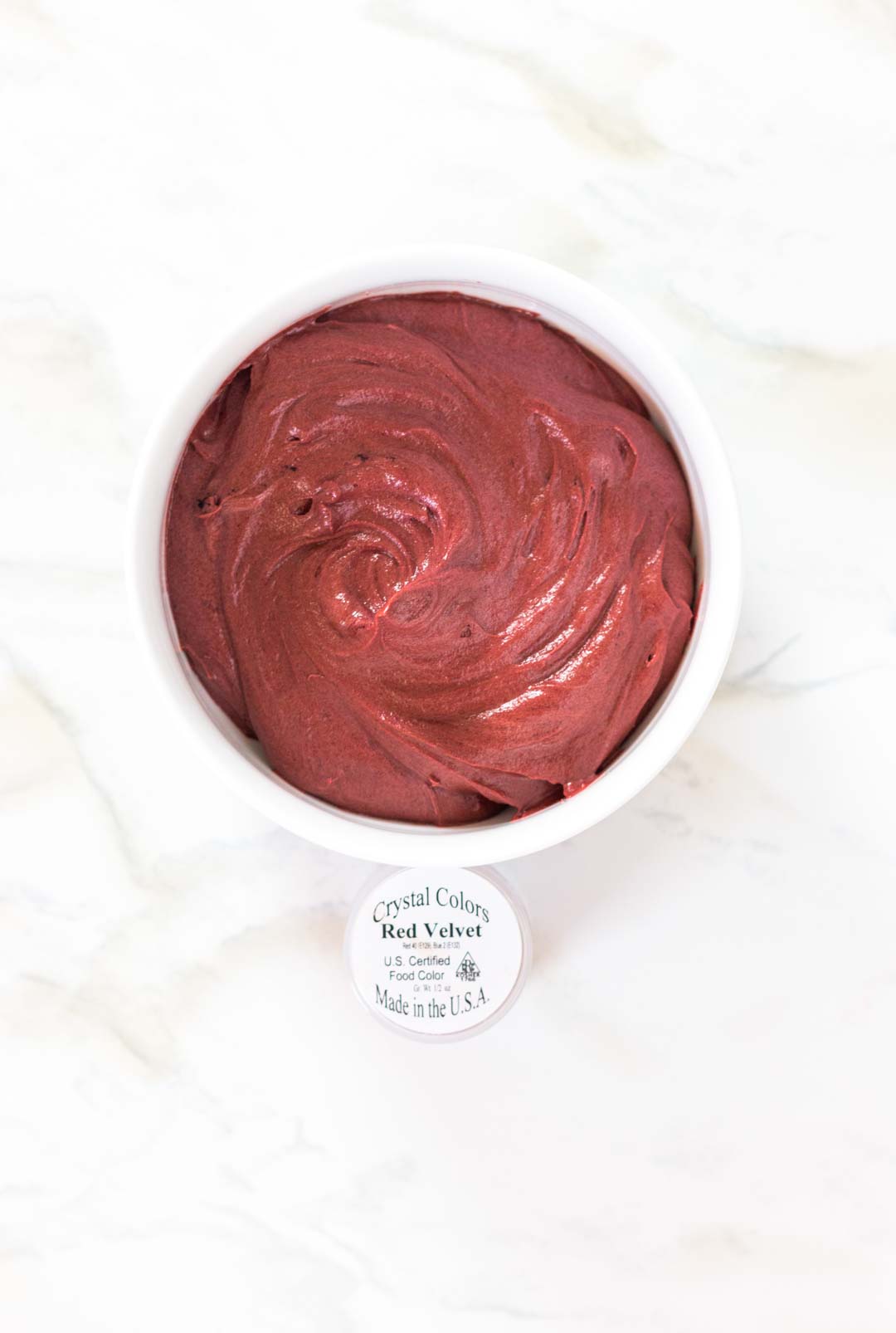
My comments:
So the red velvet powder was the closest I could find to red. That doesn’t mean they don’t have something redder, I just couldn’t find it.
Technically, it did come out a red velvet color, but only after I added a ton of it and also cocoa powder. Since powder coloring is more expensive and I ended up having to use more of it than the gel coloring, it just didn’t seem very economical to me.
I LOVE this powder color for my gumpaste flowers and fondant toppers etc., but for coloring buttercream, I just wasn’t impressed.
Update: I’ve been told that powdered food coloring needs to be dissolved in a small amount of liquid first and then added to the buttercream. It’s possible this would work better and it’s an experiment I’d need to do at some point.
Charcoal Powder Color:
I mixed together:
- 1 cup of buttercream
- 2 tsp. cocoa powder (You can also use black cocoa powder which doesn’t have as strong a chocolate taste.)
- 2-3 teaspoon powder color
The result:
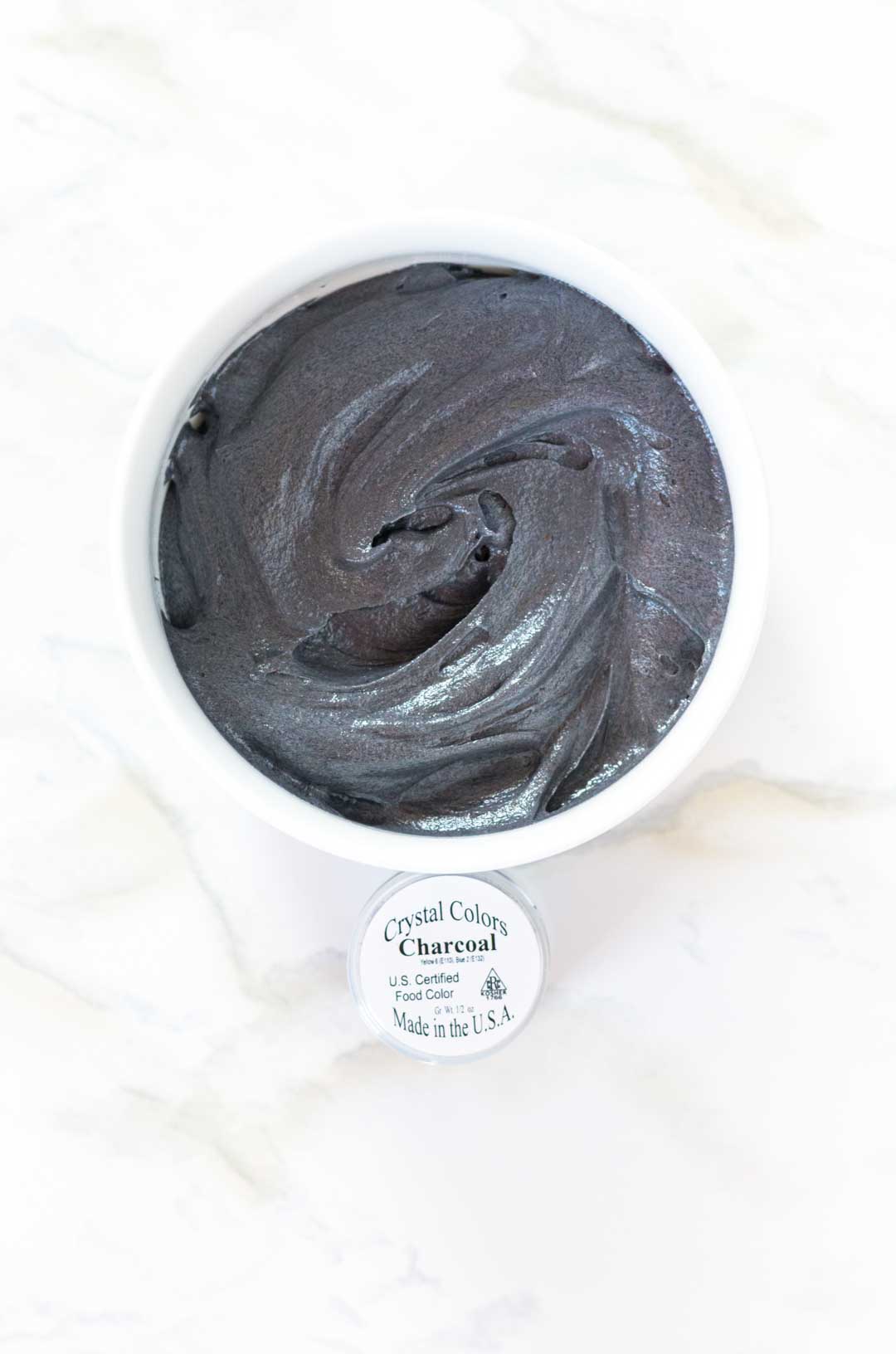
My comments:
The charcoal color was the closest I came to black and like my comment above for the red color, although it did technically end up a charcoal color, I ended up having to use a lot of it, plus adding in the cocoa powder. It just isn’t economical, but I’m still loving the powder color for other uses like gumpaste and fondant decor.
Update: I’ve been told that powdered food coloring needs to be dissolved in a small amount of liquid first and then added to the buttercream. It’s possible this would work better and it’s an experiment I’d need to do at some point.
Crystal Colors Powder Coloring Side by Side Results:

Overall Comparison:
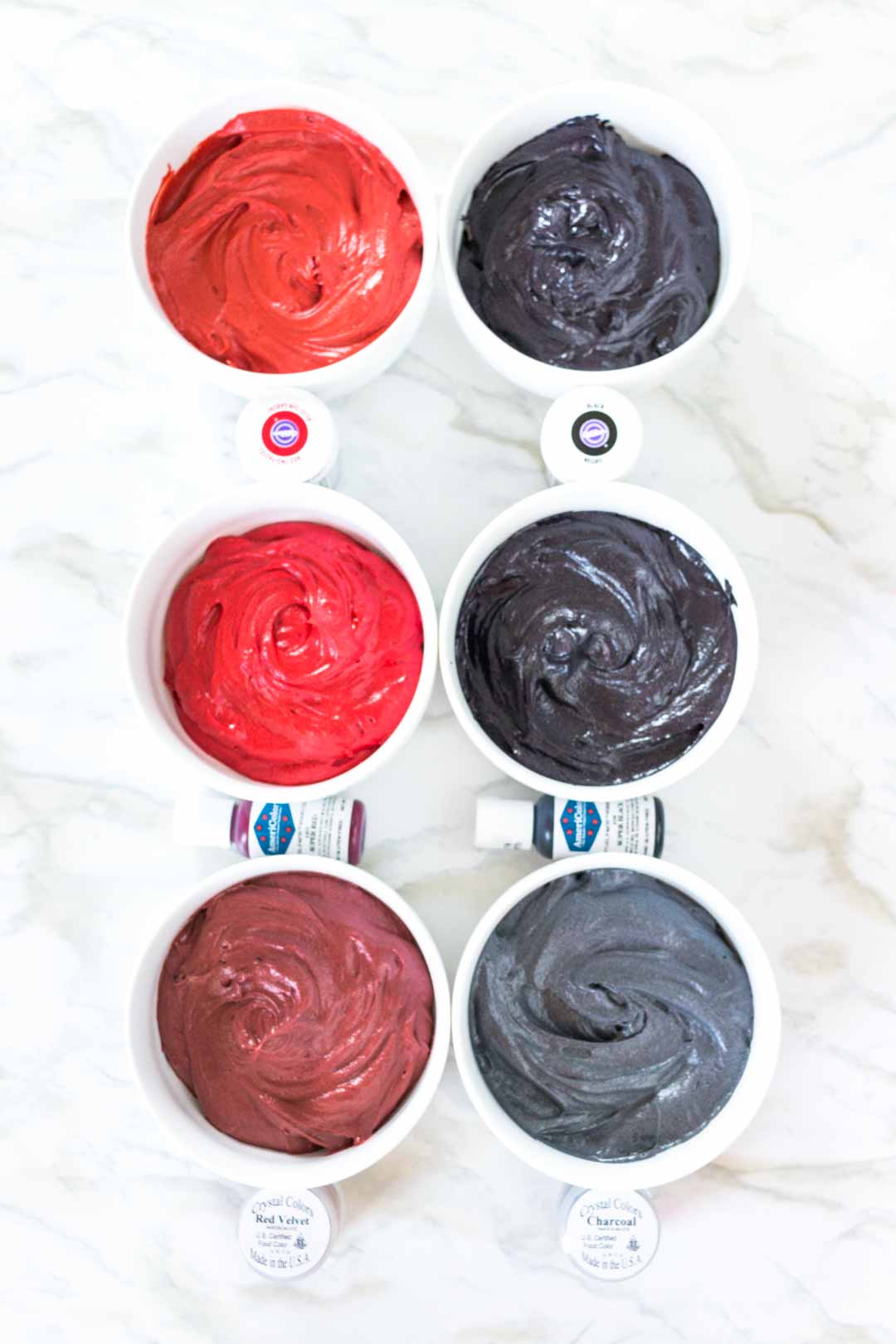
My pick:

Final Thoughts:

I really liked the Americolor better, especially the red. It was less orange than the Wilton color. You may need to make sure your buttercream is a little thicker since the Americolor is a soft gel and adding a lot might make your buttercream a little softer. I didn’t find this to be too much of a deal-breaker though.
Obviously, the powder colors just did not work for me. I’ve heard others that love using them and perhaps they’ve used a different brand than I did. I’ve also heard you can mix them with a little liquid first to dissolve them and they work better. That’s something to experiment with.
But, technically, the powdered colors did come out as red velvet and charcoal, but I had to use SO much powder to get there and the fact that the powder is more expensive, plus having to use more, just didn’t seem worth it to me.
In tasting all of these, I did not taste a bitter taste in any of them. I will say though that cocoa powder would probably mask a bitter taste and your taste buds might be more sensitive than mine.
You definitely do not have to add the cocoa powder, but it does help give it a deeper color without having to add as much food coloring in.
I would do a test run if you don’t plan on adding any cocoa powder to the buttercream. And just know that you may need to add a bit more coloring since you aren’t pre-darkening the buttercream with the cocoa powder.
New tip about adding cocoa powder to get black buttercream: I’ve recently found that black cocoa powder does an amazing job at getting black buttercream and actually does not taste as chocolaty as regular cocoa powder. It gets the buttercream closer to black and you don’t have to add as much black gel food coloring.
One more important tip: Once you’ve mixed up the buttercream colors, make sure to let it sit on the counter for a while…maybe an hour or two, or even overnight and then check it again. It seems to darken as it sits.
Video:
Other Posts You Might Like:
- Red Velvet Buttercream
- Do I Have to Crumb Coat Cakes?
- Common Cake Decorating Terms and What they Mean
- 12 Simple & Easy Buttercream Cake Borders
- Black & White Cake
Don’t Forget to Pin it for Later!
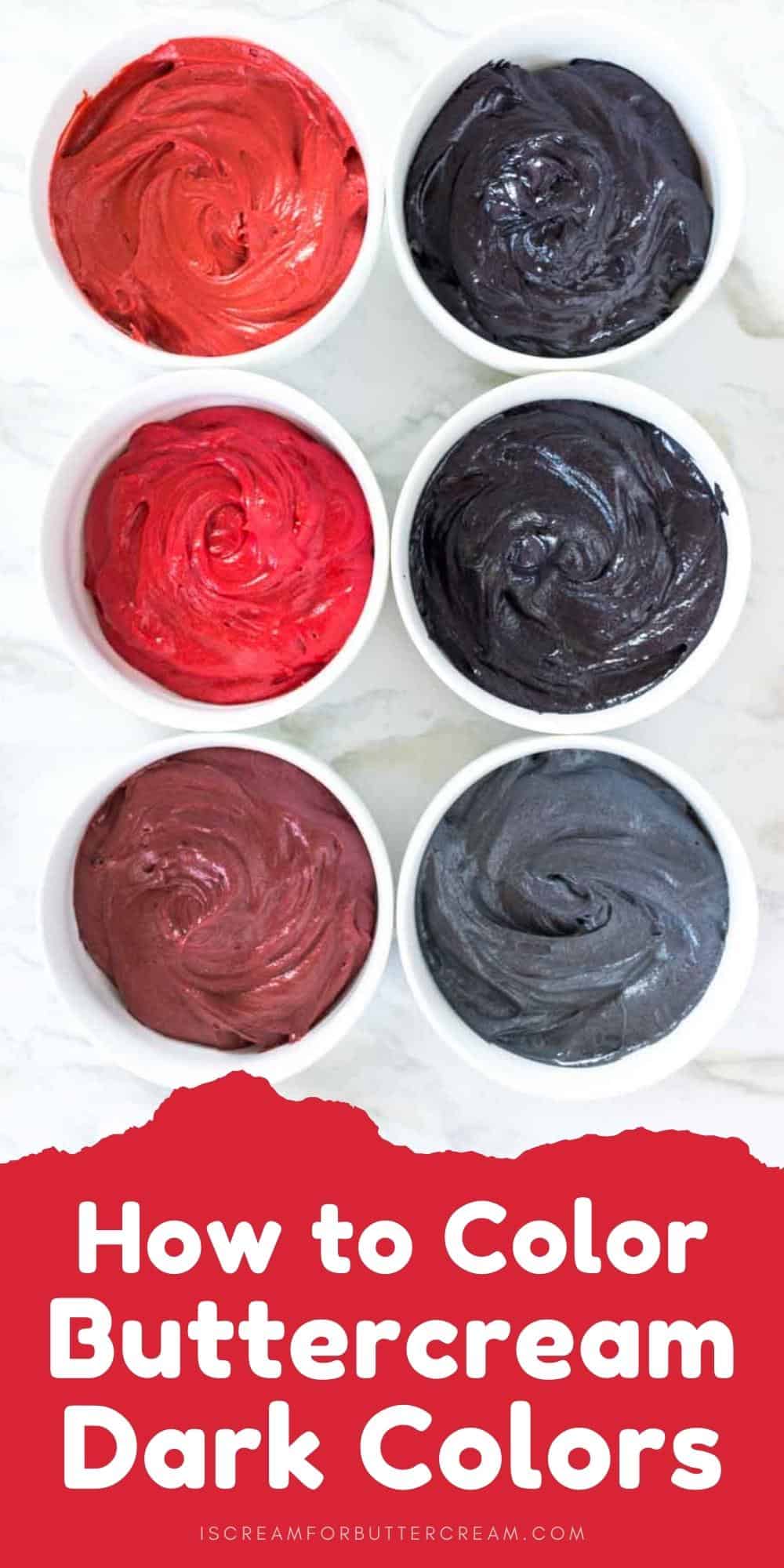

kelly
just wondering does adding the coco powder give it a chocolate taste?
Kara Jane
Hi Kelly, If you just add a teaspoon per cup, I can barely detect it. For this tutorial, I think I added in two teaspoons per cup and it was a slight taste. Others may be more sensitive to it than I am though.
You don’t have to add it though with the Americolor Gel Colors, but you might have to add just a bit more coloring to achieve a deep color.
Hope this helps!
Crystal
Is it best to mix in your color by hand or mixer ?
I feel I’m over mixing my buttercream when i use a mixer
Kara Jane
You can really do it either way. If I’ve got a large amount to color, I use my mixer. If you feel like it’s over mixing it, you could always just turn the speed down a bit on your mixer.
carol
hi i’m so glad I found your blog!!!!, I have been struggling with coloring my buttercream frosting, will this work for me if my buttercream is all high ration shortening and no butter? Please help me. Thank You for sharing your talent with all us home bakers.
Kara Jane
Hi Carol, I’m glad you’re here! Yes it will also work with shortening based buttercream as well. I use this method all the time. Let me know how it goes for you! ?
Grace
Hi would this work with Swiss meringue butter icing
Kara Jane
Grace, I normally use American buttercream but you can color Swiss Meringue as well..it’s just harder to color though. I don’t normally work with swiss meringue, but there are some tips out there that will show you how to color it. I’m going to add links here that may help: https://www.hanielas.com/how-to-color-swiss-buttercream/ and http://www.reneeconnercake.com/how-to-color-smbc/
Tracy
My daughter wants a Miraculous Ladybug birthday cake (old enough to make her own decisions now haha! ) I am going to make a pink velvet cake and just not dye it pink and then make the frosting red. Should I still use the cocoa powder or will the princess emulsion cover the taste from the Americolor gel enough? What are your thoughts? Do a test batch would probably be the best method, but honestly, I am probably going to be doing this at midnight the night before!
Kara Jane
Hi Tracy, the cocoa powder is generally used to help darken the buttercream when making dark colors…it’s a side benefit that it helps with the dye taste a little. What you can do is just make the buttercream (without the cocoa powder), then add in the coloring and see how it works. If it’s not getting dark enough, then you’ll want to add in a bit of cocoa powder to help darken it. If it’s dark enough, then you don’t have to add it. Taste it as well. If you can taste the dye, just add in a tiny bit more of the flavoring and see if that helps.
Tracy
Thank you! You are such a great source for my questions!
Jill
I’m hoping you can help me. I make a frosting (consisting of powdered sugar, milk, butter, and vanilla) for sugar cookies. It is similar to buttercream. I’ve tried to thin it down enough to flood cookies, as you would with royal icing, but the colors end up looking grainy, especially darker colors. For example, I made gray frosting, but with the grainy look, it ended up looking like a granite rock. Since I was decorating tombstone cookies, the appearance worked, but it isn’t so great when I want a nice smooth-looking color. Any ideas why this keeps happening?
Kara Jane
Hi Jill, I think that’s just going to be a problem when using thinned down icing…it seems to go grainy. I’ve seen it happen and I’m not really sure how to solve that other than using royal icing.
Sara
You could try using 1 c powdered sugar, 2 tsp milk, 1/4 teaspoon vanilla, and 2 tsp light corn syrup. This mix you can make as thin or thick as you want by adjusting the powdered sugar. It also colors nicely and hardens when it dries. I have also found that the colors don’t bleed like in other recipes.
Joanna
Hi Kara Jane! I’m fairly new to Pinterest and have enjoyed it since hunkering down because of covid. I enjoyed your thoroughly researched and beautifully well-written pin. (Yes, I’m a paralegal too lol.) Purple Rain: yes, please. Your “Item #5”: yes, please. BTW Texans have THE best accent. Thank you for being You and using this forum to make the world a better place … Best regards –Joanna
Kara Jane
Awe thanks so much Joanna!
Rebecca
I have a question about the Americolor food coloring — So I’m newer to baking, and I’ve always had good results with Wilton’s food gel colors. (haven’t done much with red or black though)
As I’m running low, I was researching into options and what other people have had success with and I see a good handful of bad/negative reviews for Americolor on Amazon. People saying the dye separated in the bottle and others saying the dye turned grey after the bottle was open for a period of time. Have you had any experience with these problems? Is it worth the cost difference in the end?
Kara Jane
Hi there, I’ve never had that experience with Americolor. I’m sure it’s possible that it happened to people, but it’s just never happened to me. I prefer the americolor red, but I also use Wilton and they work fine too. I’d say just use whichever you’re more comfortable with. I also just recently used Chefmaster gel coloring and I liked it as well. I used the neon colors, but haven’t tried their red yet.
Ana
Thank you so much for the video and for your blog! New subscriber here!
Kara
Hi Ana, glad the video was helpful 🙂